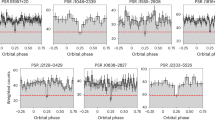Abstract
The parameters of radio pulsars in binary systems and globular clusters are investigated. It is shown that such pulsars tend to have short periods (of the order of several milliseconds). Themagnetic fields of most of the pulsars considered are weak (surface fields of the order of 108−109 G). This corresponds to the generally accepted view that short-period neutron stars are spun up by angular momentum associated with the stellar wind from a companion. However, the fields at the light cylinders in these objects are two to three orders of magnitude higher than for the main population of single neutron stars. The dependence of the pulse width on the period does not differ from the corresponding dependences for single pulsars, assuming the emission is generated inside the polar cap, at moderate distances from the surface or near the light cylinder. The radio luminosities of pulsars in binary systems do not show the correlation with the rate of loss of rotational energy that is characteristic for single pulsars, probably due to the influence of accreting matter from a companion. Moreover, accretion apparently decreases the power of the emergent radiation, and can explain the observed systematic excess of the radio luminosity of single pulsars compared to pulsars in binary systems. The distributions and dependences presented in the article support generally accepted concepts concerning the processes occurring in binary systems containing neutron stars.
Similar content being viewed by others
References
A. A. Loginov and I. F. Malov, Astron. Rep. 58, 733 (2014).
A. A. Loginov and I. F. Malov, Astron. Rep. 59, 1053 (2015).
R. N. Manchester, G. B. Hobbs, A. Teoh, and M. Hobbs, Astron. J. 129, 1993 (2005).
G. S. Bisnovatyi-Kogan and B. V. Komberg, Sov. Astron. 18, 217 (1974).
I. F. Malov and M. A. Timirkeeva, Astron. Rep. 58, 611 (2014).
A. A. Abdo, M. Ajello, A. Allafort, L. Baldini, J. Ballet, G. Barbiellini, M. G. Baring, D. Bastieri, A. Belfiore, R. Bellazzini, B. Bhattacharyya, E. Bissaldi, E. D. Bloom, E. Bonamente, E. Bottacini, et al., Astrophys._J. Suppl. 208, 17 (2013).
I. F. Malov and M. A. Timirkeeva, Astron. Rep. 59, 865 (2015).
V. V. Zheleznyakov, Astrophys. Space Sci. 13, 87 (1971).
F. Camilo and F. A. Rasio, Binary Radio Pulsars, Ed. by F. A. Rasio and I. H. Stairs, ASP Conf. Ser. 328, 147 (2005).
P. C. C. Freire, Proc. IAU 291, 243 (2013).
Author information
Authors and Affiliations
Corresponding author
Additional information
Original Russian Text © A.A. Loginov, I.F. Malov, 2017, published in Astronomicheskii Zhurnal, 2017, Vol. 94, No. 2, pp. 127–134.
Rights and permissions
About this article
Cite this article
Loginov, A.A., Malov, I.F. Parameters of radio pulsars in binary systems and globular clusters. Astron. Rep. 61, 115–121 (2017). https://doi.org/10.1134/S106377291701005X
Received:
Revised:
Published:
Issue Date:
DOI: https://doi.org/10.1134/S106377291701005X




